This Top 10 Family Board Games article is an overview of the current situation in the board gaming market. I made thorough research, so you don’t have to. Check out which board games are best for your family!
Introduction to Top 10 Family Board Games in 2023
Let’s first discuss what we’re looking for in a family game.
- The game must be at its best with 4 players. This is the standard family-size number. It’s also a bonus if it works for other numbers, especially 3 and 5.
- Light/medium in complexity. We must take into account that there will be some parents or younger teens that are not gamers, thus the games must be easy to learn and get into.
- You also don’t want the game to drag on for too long. Let’s say that 1 hour is a maximum. Any longer than this, the game must be really outstanding.
- The theme must be appealing and enticing. It must help alleviate the learning curve and immerse you for the entire playtime.
- The game must promote a friendly environment. So, no backstabbing, plotting, and so on. A friendly competition.
I haven’t included classics like Catan, Scrabble, Monopoly, Risk, or Clue, because I believe the modern board games have far surpassed them in all aspects of gameplay, balance, and theme.
How To Get Your Family To Play Board Games? – 5 Steps
New to board gaming? Read our FAQ.
Table of Contents
- Bonus: Honorable Mentions from 21 to 11
- 10. PARKS
- 9. The Isle of Cats
- 8. Clank!: A Deck-Building Adventure
- 7. Sagrada
- 6. Ticket To Ride
- 5. 7 Wonders
- 4. The Quacks of Quedlinburg
- 3. Azul
- 2. Wingspan
- 1. Everdell
There are affiliate links by the titles. I am affiliated with Amazon (as well as with some other stores) and will earn a commission if you buy something through my link.
Bonus: Honorable Mentions from 21 to 11
21. Solitaire
Players: 1+
Playing Time: 10-20 minutes
Complexity: Easy-HardThe game of Solitaire is a classic, and through its many years it has inspired multiple variations of the game, online. Solitaire Bliss offers a wide range of solitaire games to enjoy at your leisure. With a user-friendly interface, you can easily navigate through different variations of Solitaire, including Klondike, Spider, Freecell, and more. The site provides customizable options, hints, and an “undo” feature, making it a perfect destination for solitaire enthusiasts to relax and challenge themselves. Play solitaire online here.
20. Takenoko
The Emperor has entrusted you with taking care of his panda bear and cultivating bamboo in the gardens, where the panda lives. Read more here.

19. Imhotep
Become a master builder in ancient Egypt, and compete at hauling stones to five monuments.
18. King of Tokyo
Play as a giant monster (imagine Godzilla) and compete with other players in destroying the city of Tokyo. Or, if you prefer a western metropolis, try out King of New York.
17. For Sale
A quick, fun game about buying and selling real estate for the greatest profit possible.
16. Camel Up
Race camels around a pyramid, while also gambling on the outcome.
15. Quadropolis
Each player builds a metropolis on his 5×5 grid, competing for scores.
14. Small World
An area-control strategy game with dozens of fantasy races battling it out. Read more here.
13. Bärenpark
Build a bear park (featuring several bear subspecies) on your board with polyomino tiles.

12. Cryptid
Be the first to locate a cryptid monster in this deduction/deception game. Study the footage, and connect the dots, but don’t give too much away to other players!
11. The Quest for El Dorado
A race through a South American jungle, where explorers compete in discovering the legendary city of El Dorado.
10. PARKS
Designer: Henry Audubon
Year published: 2019
Players: 1-5, best with 3-4
Playing time: 30-60 minutes
Complexity: medium

Theme and Setting
Parks is a board game celebration of 48 US National Parks, their diversity, and their natural beauty. Each of the parks comes with a wonderful artistic impression. 38 artists have been included in the project and other cards and components are on a similar level.
Game Mechanics
But the beauty without sustenance is just a wall painting. Luckily, there’s a game behind the facade.
The goal of Parks is to collect as many points by hiking on a trail. This is a one-way track. Players move their two hikers, collect resources, take pictures, swap resources for wildlife, trade them, or save them for end-trail actions.
End-trail actions are reserving a park to visit later, buying gear (that helps with resource collecting), or actually visiting a park by paying. This last option is the most profitable point earner.
Other ways to earn points are to take pictures at certain locations, be the last to reserve a park or meet your pre-game goal (often dictating how many parks you have to visit).
The hike is then repeated three more times, with one additional hike space added every round and shuffled. Points are added up at the end.
Parks is not a complicated game, but there is still room for strategy. Blocking hike spots is one such. Only one hiker can be on a spot at once (unless you use a bonfire card) and you can only move them forward. Deciding where and when to move your hikers is the essence of Parks. Sometimes you want to rush ahead, other times you’ll want to leave one behind, or move at a snail’s pace with both.
Decisions are heavily affected by player count which directly impacts how much competition there is on the hiking trail. Rules for solo mode are included.
Gear, year cards, weather, goals, trail shuffling, and various parks ensure no two games are the same. You have to adapt your play. But don’t expect a brain burner from Parks – it’s still on the lighter side when it comes to complexity.

Expansion
PARKS: Nightfall Expansion (2020) adds 17 new parks, new year cards, bonus scoring cards, and a new camping mechanic.
Main Features
- Excellent components with truly beautiful artwork.
- Smooth gameplay with plenty of variety.
- Strong theme with educational and environmental components.
Who is Parks for?
If your family enjoys games that look fantastic on the table and is nature-oriented, Parks is a great way to explore them without actually leaving the living room. Don’t forget about the educational component.
Tokaido is a similar zen-tourist game.
It’s perfect as a family game, but it won’t satisfy hardcore gamers – unless played as a side game.
9. The Isle of Cats
Designers: Frank West
Year published: 2019
Players: 1-4, best with 3
Playing time: 60-90 minutes
Complexity: medium
Theme and Setting
Almost every family has a cat lover, doesn’t it? What better then than a board game centered around feline species?
You are on a mission. Your boat is on its way to The Isle of Cats and your job is to rescue as many as possible from the evil Lord Vesh.
Game Mechanics
Isle of Cats uses card drafting and grid coverage as its main game mechanics. Each round you’ll receive 20 fish tokens (the game’s currency) and 7 cards. Cards are drafted in a pick-and-pass manner, very similar to 7 Wonders or Sushi Go.
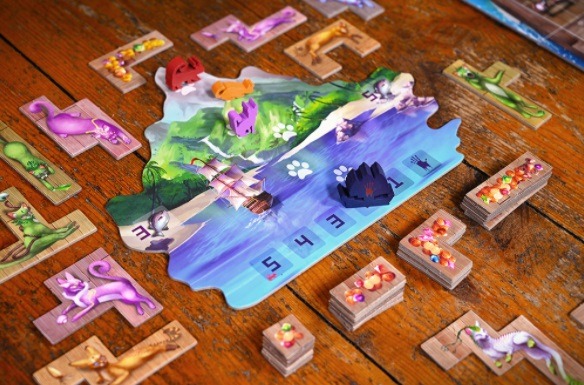
When you decide which cards to keep, you must pay their cost in fish. As the cards are played out, actions on them are carried out. There are four major types of cards:
- cards used to rescue cats,
- cards with objectives,
- treasures,
- special abilities.
The deck of cards is a lot larger than what you would normally see in one game, so there’s plenty of variety available. Yet, the card types remain basic and are really easy to understand.
As the cats are saved, you place them on your ship. Cats come in different Tetris-style shapes and filling the grid optimally is a game on its own. To score as many points as possible, you have to group cats of the same color and cover the negative victory points tile (rats) on the ship.
Saving cats costs fish too, so you must strike the right balance between buying cards and saving fish. Cats are your main points of income, yet those cards look so lucrative and tempting …
After five rounds the game ends. Players get points for groups of cats, completed objectives, treasures, and negative points for any remaining rats.
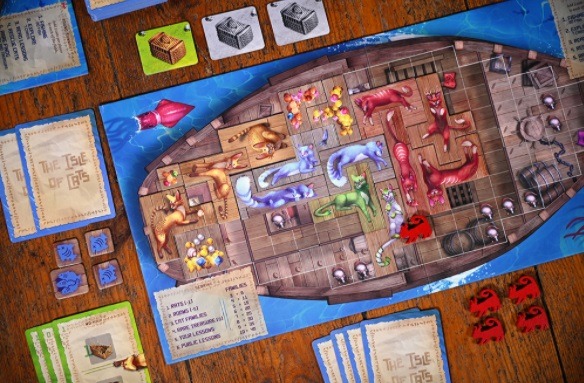
Expansions
The Isle of Cats: Late Arrivals (2019) adds 2 new player boats, which means up to six players can play now. More cats and cards are included as well.
The Isle of Cats: Kickstarter Pack (2019) features even more cards and cats, together with premium wooden fish tokens.
The expansions are nice, but they are nowhere essential for a good experience. Moreover, they are very hard to find in retail.
Main Features
- Very appealing theme with beautiful artwork.
- Easy to learn, but engaging game mechanics.
- Good replay value.
Who is The Isle of Cats for?
The Isle of Cats works excellently as a family game. The rules are simple and easy to learn (an even simpler version of rules is included for absolute beginners/kids), the artwork is colorful and the cat theme is very compelling.
The game runs smoothly and filling your ship with cute cats is engaging and fun. I recommend this to every cat-lover board gamer.
8. Clank!: A Deck-Building Adventure
Designer: Paul Dennen
Year published: 2016
Players: 2-4, best with 3-4
Playing time: 60-90 minutes
Complexity: medium
Theme and Setting
The Clank! franchise is a very popular push-your-luck deck-builder. You play as fantasy characters (thieves if you like), whose task is to get into a dungeon (or an overworld/space equivalent of it), retrieve one or more treasures, and come back out alive.
What you can do in a turn is determined by a deck of cards, which you enhance during the game. The push-your-luck element is implemented as Clank!, the noise you generate.
Game Mechanics
The main goal is to retrieve an artifact from below the ground and get it back safely. You start a scenario with a deck of 10 cards out of which you draw 5 to your hand. The symbols on them then tell what you can do. If you want to move, you need boot symbols, to fight you need sword symbols, and so on. Many locations require a combination of symbols.
Of course, getting loot doesn’t help much, if you’re not the one with the most of it. Players constantly monitor one another and their loot piles. Then you have to decide whether you’ve had enough and get back above or stay a bit longer below the ground.
The dragon and Clank symbols (that gave the game its name) take care of the push-your-luck side. Here’s how it works. Some cards also have clank symbols, creating noise. When playing those, you must place a certain number of cubes in your color into a bag and when the dragon rages, a certain number of cubes are pulled out. Players then suffer damage to their health according to colors pulled out.
The main game mechanic is deck-building. You start each scenario with a deck of ten cards, but you will be able to add new cards to your deck during a scenario. You’ll start by adding basic Explore and Mercenary cards, with more advanced cards later on.
The variety of cards is very high. There are cards, that help with collecting loot, drawing extra cards, helping with movement, combat, and so on. You’ll have a lot of freedom building your character’s deck and, since the cards available for purchase are drawn randomly, your deck will evolve in each game differently.
As the players get out of the dungeon, they get their loot scored and the one with the most points wins. There are bonuses for cards, escaping, and so on. Even if you die (above ground), you can still get points. The town folks rescue you, but strip you of bonus points.
But if you die beneath the surface, you remain in the depths, forgotten and eliminated from the game.
Expansions/Editions
After the original Clank!, three standalone titles have been released:
- Clank! In! Space!: A Deck-Building Adventure (2017), a revised edition in a space-themed world.
- Clank! Legacy: Acquisitions Incorporated (2019), a legacy variant with a strong story, campaign, and progression.
- Clank!: Catacombs (2022), where the dungeon is not pre-determined, but the players build it as they play.
On top of those, each of the older titles has received a myriad of expansions, adding new boards, cards, bosses, and characters. Clank! is a big universe and you won’t run out of things to play (and buy) anytime soon.
Main Features
- A lot of deck-building options.
- The dragon produces a lot of tension.
- Competitive, but without much interaction.
Who is Clank! for?
Clank! is an excellent deck-building adventure and with the dragon, the games are on the knife’s edge to the very end. It takes a bit for new players to get behind it, but it will pay you back with a very engaging stealthy-thief experience.
I recommend it to fantasy-loving families that have a bit of a background in board gaming.
7. Sagrada
Designers: Adrian Adamescu, Daryl Andrews
Year published: 2017
Players: 1-4, best with 2-4
Playing time: 30-45 minutes
Complexity: light/medium
Theme and Setting
Did you know that Sagrada Familia, the famous basilica in Barcelona is under construction since 1882 and it’s still not finished? Well, maybe you can help out. Stained glass windows need someone to craft them. Will you be the artisan with the most beautiful design?
Game Mechanics
In Sagrada, you will draw dice from a bag and then place them on your window card, following your goals, and public objectives, and obeying rules for placing them.
Players receive window pattern cards, which they insert into their frame board. These pattern cards tell you how you can (and must) place dice. They come with various difficulties – the more difficult the card, the more favor tokens you receive. You can spend those on tool cards (special actions). Besides tool cards, public goals are placed on the table. These depict certain dice positions and are a chance to score some more points if you fulfill them on your board.
Sagrada is played over 10 rounds. In each round, one of the players draws dice from the bag (i.e. 7 dice for a 3-player game) and rolls them. Then players place them on their boards, with each player taking two turns.
On your turn, you will take a die and place it on your 4×5 board. Then you also have the option to use a tool card for a price of a favor token.
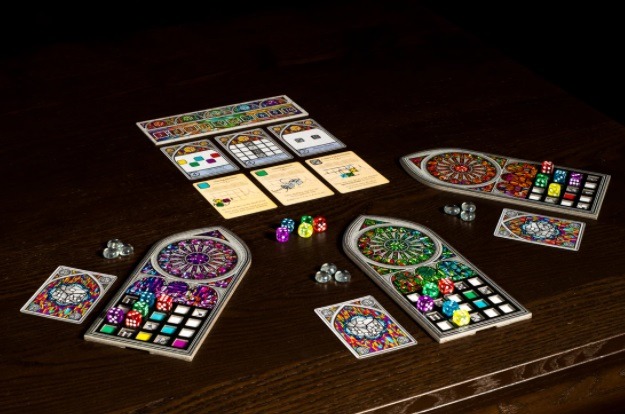
What makes the game interesting are the dice-placing rules:
- You must at all times obey your insert, commanding you which color or number can be placed on a spot.
- The first die must be placed on an edge or corner spot. Every other die must be adjacent (diagonally counts too) to an already placed die.
- Dice placed adjacent orthogonally can never be of the same color or number.
These rules complicate the simple mechanics quite a bit. Together with objectives and available tools, the placement of dice is not nearly as straightforward as you would have thought.
After ten rounds, the points for public and private objective cards, and unspent favor tokens are added together. You lose a point for each open space on your board. The player with the most points wins.
Expansions
Besides promo and fan-made window pattern cards (some of those can be printed for free), there are three larger expansions known as The Great Facades series:
- Sagrada: The Great Facades – Passion (2019) introduces inspiration cards, rare glass dice and cards, rare glass private objectives, and symmetry public objectives.
- Sagrada: The Great Facades – Life (2020) adds apprentice cards and masterwork dice. You can gain prestige by tackling tricky new restrictions.
- Sagrada: The Great Facades – Glory (2022).
Expansions rectify the lack of variability from the base game and add some meat to the bone. The question is whether it’s worth enhancing Sagrada or whether you would be better off investing in a more complex game in the first place.
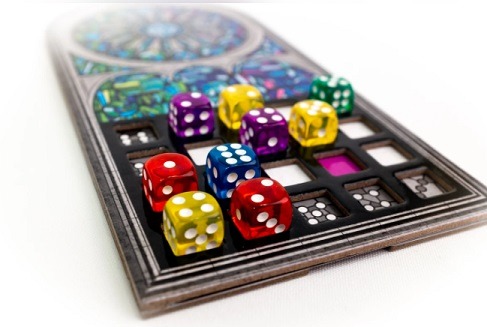
Main Features
- Well-thought-out rules for dice placement.
- Enjoyable and simple gameplay.
- Nice looks.
Who is Sagrada for?
Sagrada is a great little game. You can teach anyone to play, even your non-gamer grandparents or kids, and they will easily understand how it works – it doesn’t require any previous gaming experience.
With so many dice of 5 different colors, it looks very enticing on the table. It does lack a bit of variety and longevity (expansions can help here), but for casual family play, it’s perfect.
6. Ticket To Ride
Designer: Alan R. Moon
Year published: 2004
Players: 2-5, best with 4
Playing time: 30-60 minutes
Complexity: light
Theme and Setting
Trains are an impressive contraption. There’s something majestic about a thousand-tonne monster whizzing by. No wonder many kids and adults are fascinated by their appearance and they are a common theme in gaming.
Link to article about Best Train Board Games
Ticket to Ride re-invented trains and board gaming. The impact it had on the popularity of board gaming cannot be underestimated. It introduced legions of new players to the hobby and has replaced Monopoly as a go-to family board game.
Game Mechanics
Its secret lies in its simplicity. Each turn, you collect cards of different colors. You then have the option to place the cards as wagons on a matching track on a map. You can also hold on to your cards, saving them for longer routes. This can be profitable, but risky since other players can claim those routes before you and leave you hanging.
Objective cards are there to give your actions meaning. They are orders on connecting certain cities and they give a lot of points when finished.
When players run out of wagon tokens to place, the game ends, and the points are added together. Your routes are scored depending on the length and your objectives are scored on top of that.
Despite its simplicity Ticket to Ride still allows for some strategy: holding to your cards or playing them now, obstructing other players, hiding your agendas, etc. Still, the rules are easy to understand and, what is more important, intuitive and natural.
Successive editions add more game mechanics: tunnels, ferries, stations, ships, harbors, and others while maintaining its simplistic winning formula. There is something for every taste.
Expansions/Editions
- Ticket to Ride (USA); 2004
- Ticket to Ride: Europe; 2005
- Ticket to Ride: Märklin; 2006
- Ticket to Ride: Nordic Countries; 2007
- Ticket to Ride: Deutschland; 2012
- Ticket to Ride: Rails & Sails World; 2016
- Ticket to Ride: Rails & Sails Great Lakes; 2016
- Expansions and map collections are available for many of the above titles.
- Standalone Spin-offs like The Card Game, First Journey, London, and New York.
Main Features
- A modern-day classic.
- Easy to learn – great for introducing new players to board gaming.
- Plenty of editions to satisfy different tastes.
Who is Ticket to Ride for?
Ticket to Ride is not only a mandatory addition to any board gamer’s shelf but also an essential entertainment tool for a modern family. It’s something everyone can get into and enjoy instantly. Choo-choo!
5. 7 Wonders
Designer: Antoine Bauza
Year published: 2010
Players: 3-7, best with 4-5
Playing time: 30 minutes
Complexity: medium

Theme and Setting
The Pyramids, Hanging Gardens, Statue of Zeus, Colossus, Temple of Artemis, Great Lighthouse, and the Mausoleum of Halicarnassus were the most prominent monuments of the ancient world.
Now is your chance to re-live that era. Develop your civilization, gather resources, build ever-advanced buildings, and finally construct one of the Wonders.
Game Mechanics
7 Wonders is a card-drafting tableau-building board game. You draw cards from a hand and place them in front of you.
Each player is dealt a hand of 7 cards. You then select one of the cards and use it in one of three ways:
- add it to your tableau,
- discard it for money, or
- use it to construct a wonder.
The remaining cards are passed on to your neighbor and you repeat the process until only one card is left in your hand, which is discarded. The whole process then repeats two more times (Era II and III) with stronger sets of cards. Between eras, military might is checked and victory points are given out. After era III, final scores are added together and the winner is declared.
Basic cards produce resources, which are needed for the construction of more advanced buildings and wonders. Other buildings give you the option to trade with your neighbors, grow militarily, and provide scientific symbols, or victory points directly.
There are several types of cards, like military, commercial, scientific and cultural buildings, that you stack in front of you. As said, many of them require resources or other prerequisites to be built (sometimes you can build for free if you have a prerequisite building).
That’s more prominent in later eras, where the buildings are increasingly more expensive, but also give out better rewards. This is especially true for wonders, ultimate buildings, that can really turn the tide of the game.
To be able to afford those late-game buildings, you must build up your engine wisely. Choosing the right cards (and at the same time denying them to your opponents) is crucial. If your neighbor is going for the military might, there might not be enough military cards left and you’ll be better off specializing in commerce, for example.
There is a limited number of cards in each game, so you must weigh your priorities carefully and adapt. Although you’ll get to see most of the cards in a game, you won’t ever have the chance to choose the same ones.
While the rules are really simple, there are a lot of symbols on the cards and these are sometimes not intuitive and require referring back to the rulebook. After a few games, things will get smoother.
And you can play those few games really fast. The average games last around 30 minutes (maybe a little more) and this is almost independent of the player count. Players take their turns simultaneously and the game scales really well from 3 and up to 7 players, without too much extra playing time.

Expansions/Editions
7 Wonders has received 5 expansions (not counting fan-made):
- 7 Wonders: Leaders (2011) adds Leader cards (you can play one at the beginning of each era), which personalize your civilization more. One new Wonder is also included – the city of Rome.
- 7 Wonders: Cities (2012) introduces a whole new type of cards (black cards, that add more interaction between players) support for the 8th player, 2 new wonders (Petras and Byzantium), and optional team-play rules.
- 7 Wonders: Wonder Pack (2013) comes with 4 new wonders: Great Wall, Stonehenge, Abu Simbel, and Manneken Pis.
- 7 Wonders: Babel (2014) deepens the game mechanics, adding 2 new: laws that affect all players and taxes mechanism for certain colors of cards.
- 7 Wonders: Armada (2018) introduces a new naval board with cards for the main deck. You can now advance on the naval board, exploring the world. You can find victory points, and resources, increase your naval power, and so on.
You can combine any number of expansions with the base game. Cities and Wonder Pack are too good to pass, while other expansions I’d consider optional.
The lackluster 2-player game has been addressed in 7 Wonders Duel, a standalone title with different draft mechanics. It’s arguably one of the best 2-player board games.
Main Features
- Simple drafting mechanics ensure fast gameplay.
- A lot of civilization-building options.
- Equally good at 3 and 7 players.
Who is 7 Wonders for?
7 Wonders is an excellent family game. You can learn it in one play, and it works great with all player numbers. It offers a lot of strategies for more advanced players and you can scale that with expansions easily.
But don’t worry. If your family wants to travel to ancient times, the base game will do just fine. Get the 2nd Edition if you can.
4. The Quacks of Quedlinburg
Designer: Wolfgang Warsch
Year published: 2018
Players: 2-4, best with 4
Playing time: 45 minutes
Complexity: light/medium
Theme and Setting
The 9-day Quedlinburg festival is in full swing. You are there too, trying to make a quick buck by selling people a potion that will magically solve all their troubles. Pumpkins, mandrakes, crow skulls, spiders, and even rat tails – there’s nothing you won’t try to stuff in your cauldron.
But you’re not the only quack at the festival. You’ve got competition. Can you beat them in making the best potions?
Game Mechanics
The Quacks of Quedlinburg is a bag-building push-your-luck game. It’s played over 9 rounds and you will brew a potion (or fail) every round. You draw ingredients from a bag and then place them on your personal board (cauldron). Each cardboard chip comes with a color (type of ingredient) and a number, that tells you how many spaces you advance on the cauldron’s track. The further down the cauldron you advance, the more points and money you will get at the end of the round.
But among the ingredients are also white cherry bombs – draw a total number of 7 of them and your potion explodes, ending the day for you and preventing you from buying extra ingredients.
You can buy the ingredients in between the rounds. They come with all sorts of crazy powers and abilities, i.e. acting as multipliers, bonuses, making it harder to explode, and so on. After 9 rounds, the points are added up and the winner is declared.
There are a few additional mechanics, like the bonus die for the round winner, fortune teller cards that provide bonuses, a flask that lets you remove one cherry bomb, or rat tails that act as a catch-up mechanism, should someone run too far ahead. On top of that, you can swap out ingredients for another set and transform Quacks into a fresh form. Indeed, the variability in The Quacks of Quedlinburg is really high. Complexity ramps nicely through the rounds.
But the main attraction is the excitement when reaching into your bag. From cheerful joy to disappointing ahhs, Quacks won’t leave anyone indifferent. You vaguely remember putting a couple of really good chips in there two rounds ago. But you’re so close to exploding, should you risk it and draw one more?
The gameplay is so engaging that you even forget that, although you have a decent influence over your bag, a large part of the outcome depends a lot on luck. It’s just fun seeing your potion coming out of the bag.
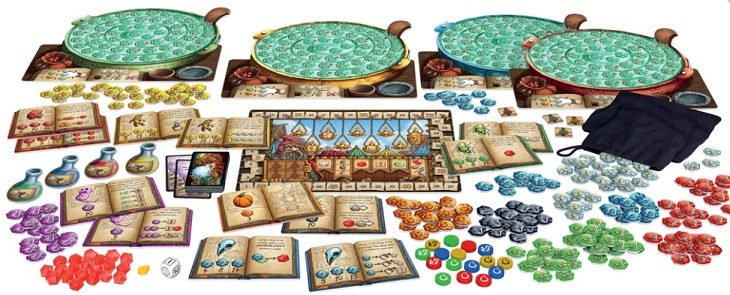
Expansion
The Quacks of Quedlinburg: The Herb Witches (2019) adds a board for the 5th player, more ingredient books, a new herb, and a couple of other things, further increasing variety.
Main Features
- Very exciting push-your-luck mechanics.
- A lot of variety.
- Simple, quick, and immensely fun.
Who is it for?
The Quacks of Quedlinburg is one of the finest push-your-luck examples. It’s a gambler’s game but enjoyable regardless of what comes out of the bag. It’s not a game where you’ll be analyzing the board for minor gains – it’s an easy-to-pick-up instant dose of excitement.
The rules and the basic concept are easy to understand. Even new players can learn the core gameplay in minutes. The game also runs fast, regardless of player count – you can draw ingredients simultaneously.
I recommend The Quacks of Quedlinburg very much and don’t really have any negative things to say, except that the chips may wear down if you play a lot (which you probably will). Premium components are available from third parties, though.
3. Azul
Designer: Michael Kiesling
Year published: 2017
Players: 2-4, best with 2-3
Playing time: 30-45 minutes
Complexity: light
Theme and Setting
In Azul, players collect sets of tiles from the central offer and place them on their player boards, forming collections and patterns of five different colors. And eventually scoring points for those patterns.
Game Mechanics
In the center, there are a certain amount of factories (there are five for a 2-player game), each offering 4 tiles. Players alternate turns picking which factory to collect.
When collecting, you take all the tiles of the same color that are on that factory. The rest is moved to the center pile, forming another, wild, factory. From now on you can also choose to take from the center factory, but the first player to do so in a round will get one negative point.
You place the collected tiles on one of the five rows on the bottom left of your player board. The top row requires only one tile to fill, the second requires two, all the way down to the fifth, which requires five tiles of the same color to fill.
The round ends when there are no more tiles on offer. Filled rows are then scored and one tile from that row is moved to the right side pattern. Unfulfilled rows remain as they were and you can continue to fill them in the next round.
When the first player completes a row on the right side, the game ends. Therefore the minimum playing time is 5 rounds. But it is usually longer, since rushing the game just to complete won’t yield any big points.
The tiles score more when placed adjacent both vertically and horizontally, there are bonus points for completed rows and columns, or by filing every tile of a single color.
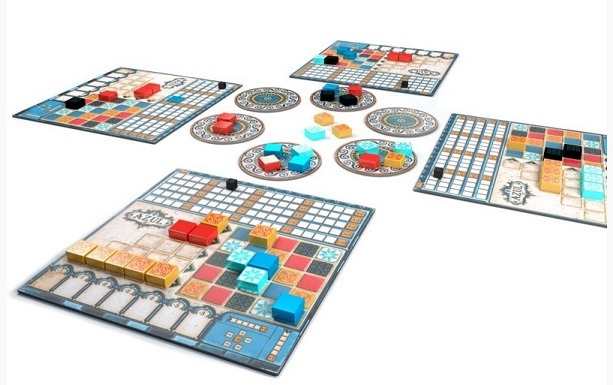
While Azul is a purely abstract game, the designers have squeezed every drop out of the theme. The tiles look and feel great and the whole game is a joy to behold.
The gameplay starts as a solitaire set-collecting, but soon things start to complicate. First, there’s the center factory. It will soon start to fill up with tiles that everyone will look to take. But who will be brave enough to take that negative point? Or should you push your luck and wait for one more turn?
As the game progresses and you close more and more slots on your right side, your options become limited. Suddenly, you’re not just looking for where you can get the most tiles, you’re looking for specific colors. So are your opponents. Azul now becomes more competitive and tense, with players denying other players access to tiles they so desperately need.
But as there’s always an alternative as to what to pick, it never turns into a war but remains rather friendly-competitive. You don’t stop the opponent from scoring, you just make them take the tiles that score fewer points.
Azul is a joy to play. The rules are easy to understand by everyone – collect these tiles of the same color until you have enough to fill a row. But being good is deceivingly hard.
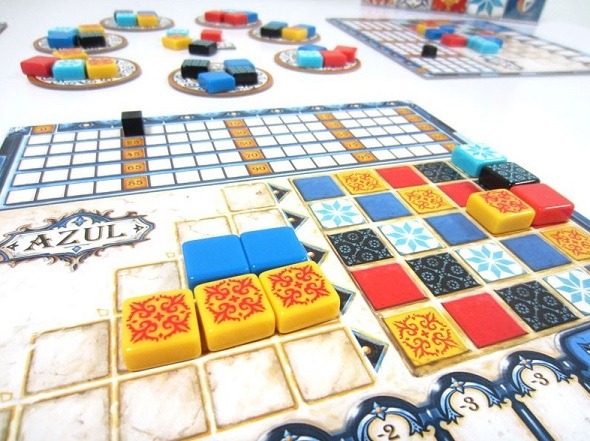
Editions
Azul: Crystal Mosaic is an expansion that adds new player boards (containing more challenging right side tables) and plastic overlays, which prevent your tiles from sliding on the board.
Azul: Stained Glass of Sintra (2018) is a standalone game, that completely revamps player boards. You’re still collecting tiles, but this time you’re placing them in pattern strips and then moving them to complete palace windows.
Azul: Summer Pavilion (2019), another standalone title with player boards changed one more time. This time you’re collecting diamond-shaped tiles, working on King Manuel’s Pavillion.
Azul: Queen’s Garden (2021)
Main Features
- Easy to learn, hard to master.
- Looks great on the table.
- A lot of replay value.
Who is Azul for?
Azul is a game of extremely low entry point, but with a high bar for advanced players. There is a lot of depth and thought in your decisions. It looks fantastic, plays quickly, and works great with all player counts.
It’s no wonder it has quickly become a modern classic. The sequels only confirm this – they offer altered game mechanics, but the beauty and elegance of Azul remain.
2. Wingspan
Designer: Elizabeth Hargrave
Year published: 2019
Players: 1-4, best with 3
Playing time: 40-70 minutes
Complexity: medium
Theme and Setting
Wingspan is about birds. Their names, appearances, sizes, where they live, and interesting facts about them. 170 bird cards are included.
Wingspan is a card-driven engine-building game. The goal is to attract birds to your habitats (your player board): forest, grasslands, and wetlands. Some birds only nest in certain habitats, while others are more flexible.
Why Is Wingspan So Popular? – 5 Reasons
Game Mechanics
The course of play is very simple and accessible. The game is played over four rounds and each lasts between five and eight turns. On his turn, a player has four options:
- Play a bird card from his hand, pay its cost, and place it in a habitat on his board.
- Gain food and activate powers on his birds in the forest.
- Lay eggs and activate powers on his grassland birds.
- Draw cards and activate powers on his wetland birds.
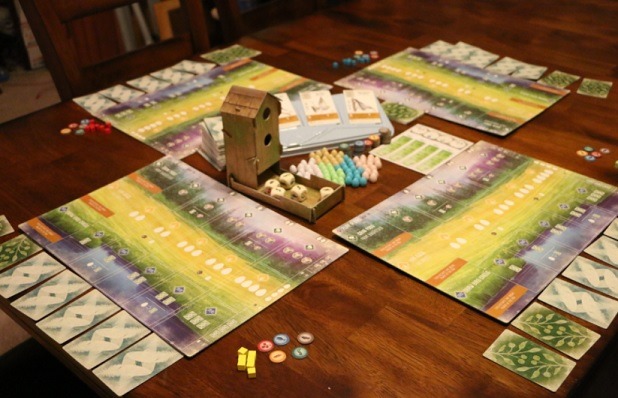
Food is a resource needed to place the birds on the board and there are several types of food: worms, seeds, fish, fruit, and rodents. Eggs are used to place birds beyond the first slot, while cards give you more birds to place.
Where it gets a bit more complicated and the game offers some tactical depth, is combining the placement of birds and their powers. Three categories of bird powers exist:
- Powers that activate when using a corresponding habitat, like gaining a type of food or tucking another bird card under it (creating a flock).
- Powers that activate between turns, usually triggered by another player’s actions.
- One-time powers that only activate when you place the bird.
On top of that, there are end-of-round special goals that are randomly selected. You’ve got to balance between achieving these mid-goals and optimizing your engine for maximum end-game score.
End-game scoring takes into account the number of birds on the mat, bonus cards, bonus points for end-of-round goals, eggs, food, and tucked cards under birds. Basically, everything you did will net you points.
Wingspan is a very balanced engine-builder. Everything you do affects something else. You need to carefully plan your moves and manage resources to activate those powerful scoring chains. That’s where the fun comes from, trial and error. As soon as you’re done, you want to play again, only to try something else or perfect your strategy.
There are a lot of birds (that means different powers) available and sometimes you won’t draw what you need and other times you’ll be lucky and get exactly what you need. This is the game’s only disadvantage. But it’s nowhere critical, especially for family play, where a bit of randomness can be just the ingredient that will lift the enjoyment one bar higher.
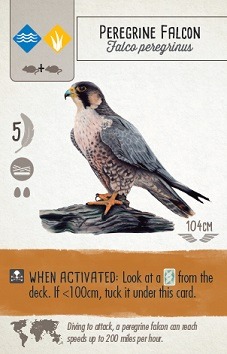
Expansions
- Wingspan: European Expansion (2019)
- Wingspan: Oceania Expansion (2020)
- Wingspan: Asia Expansion (2022)
The expansions add new cards (birds), further raising variety. The Asia expansion also doubles as a stand-alone game for 2 players.
Main Features
- Easy to learn.
- Truly magnificent components.
- Educational element.
Who is Wingspan for?
Wingspan takes several mechanisms and blends them into a new, truly enjoyable mix. The level of complexity, variety, and educational value make it perfect for families – although it may be hard for a non-gamer to get into. But it’s worth it.
1. Everdell
Designer: James A. Wilson
Year published: 2018
Players: 2-4, best with 3
Playing time: 40-80 minutes
Complexity: medium

Theme and Setting
When you think of city-building, you would first think of streets, buildings, and people. But what about a fantasy valley of Everdell? Deep in the untouched forests, a settlement of forest critters is growing. You are a leader of one such group of critters with a task to improve and enhance your civilization.
The theme is a major standout in Everdell. It’s beautiful, lovely, and cute. Illustrations are a piece of art and the components (especially the 3D Ever Tree) will turn heads. A set-up Everdell is truly a sight to behold.
Game Mechanics
Everdell is primarily a worker-placement game with a strong element of tableau-building (your city). On your turn, you have three options:
- Place a worker on locations, events, and destinations. They perform actions like gaining resources (berries, pebbles, twigs, and resin) and drawing cards.
- Play a card to your city. You can place up to 15 cards in front of you. They generate extra resources, provide special abilities, and score points.
- You can retrieve your workers, end the season, and prepare for the next one (by adding extra workers). The game is played over four seasons.
While this seems like very little to do – counting all the workers, you only get 15 worker placements in the entire game – once again, the devil is in the detail: the city/engine building part of the game.
There are 128 cards available and they come in 5 types: Travelers, Production, Destination, Governance, and Prosperity. You start with 5 cards in your hand. When placing them in your city, you must pay their cost in resources. In your city, the cards will have different roles. Some give extra resources, cards, or points, while others have ongoing bonuses, triggering every season.
Then there are the destination cards, which are another spot where you can send your workers. If you have a proper destination build, you can even send a worker there for free!
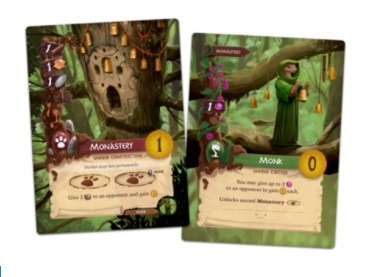
Of course, it is the synergy between your city cards that will make or break your engine. If you play them right, you can take several turns without spending any resources (or workers), chaining abilities together. This is what you should strive for and it feels very satisfying when it all works as you imagined.
This is where we come to the only minor quirk about Everdell. With a deck of 128 cards, you are in no way guaranteed to draw the right cards for your engine. You’ve got to work with what you get – but it feels frustrating to know that only if you got the right card, your engine would have steamed ahead, instead of just rolling along.
But on the other hand, the large deck provides variety and longevity. And the satisfaction on successful combos is higher this way. You can’t have it all and eventually, I think they achieved a pretty solid balance. As a bonus, there is also a very good single-player mode in Everdell. You play against Rugwort, an AI player.
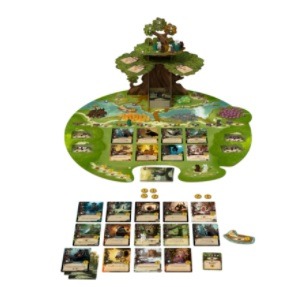
Expansions
- Everdell: Spirecrest (2019) adds new mechanics like weather cards, discovery cards, and big critters (workers with special powers).
- Everdell: Pearlbrook (2019) introduces a new river board, where you’ll send your frog ambassador to gather a new resource: pearls. You’ll also encounter new aquatic critters and constructions.
The base game, as well as the expansions, also come as the Collector’s Edition, featuring some extra cards and other goodies. Everdell: Glimmergold Pack (2019) turn the base game into a Collector’s Edition by adding all the missing cards and other pieces. There are also add-ons that turn the expansions into Collector’s editions.
None of the expansions or limited editions are mandatory purchases, though. You’re good to go with the base game.
Main Features
- Stunning art and components.
- A lot of options and variety in the engine-building process.
- The theme is very immersive and makes the learning process a breeze.
Who is Everdell for?
While there might be a bit of a learning curve for newcomers, the presentation makes the process a breeze. The core mechanics are simple and you’ll learn about the cards as you go.
There is a slightly longer game time (compared to other games on our list), but the end result will be worth it. Everdell is the best family board game.
Further reading:










